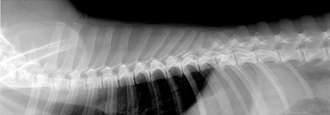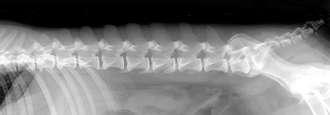 |
 |
Veterinary radiography utilizes ionizing electromagnetic radiation to view internal body structures. An x-ray machine creates the photons which pass through the body and are detected on film or computer, similar to a camera. The soft tissue in the body is composed of smaller atoms which do not absorb x-ray photons as well as larger atoms (e.g. the calcium in bones). Bones, metal and contrast media (special dye used to highlight areas of the body) block most x-ray photons and therefore appear white. Structures containing air will appear black and muscle, fat and fluid will appear shades of gray. High quality spinal radiographs are an important first step for localizing a lesion in the spine or vertebrae prior to performing advanced imaging tests such as CT or MRI. Patients are usually anesthetized to keep them still in order to obtain the proper positioning necessary to accurately view the spine. Technicians, skilled in the use of anesthesia, monitor the patient closely during the procedure.
►Click here to learn more about x-rays and radiography.
This information is meant to be a guide and not a substitute for veterinary care.
Always follow the instructions provided by your veterinarian.
Commonly Radiographed Neurological Areas:
Spine
- cervical
- thoracic
- lumbar
- sacrum
Head
- brain/skull
